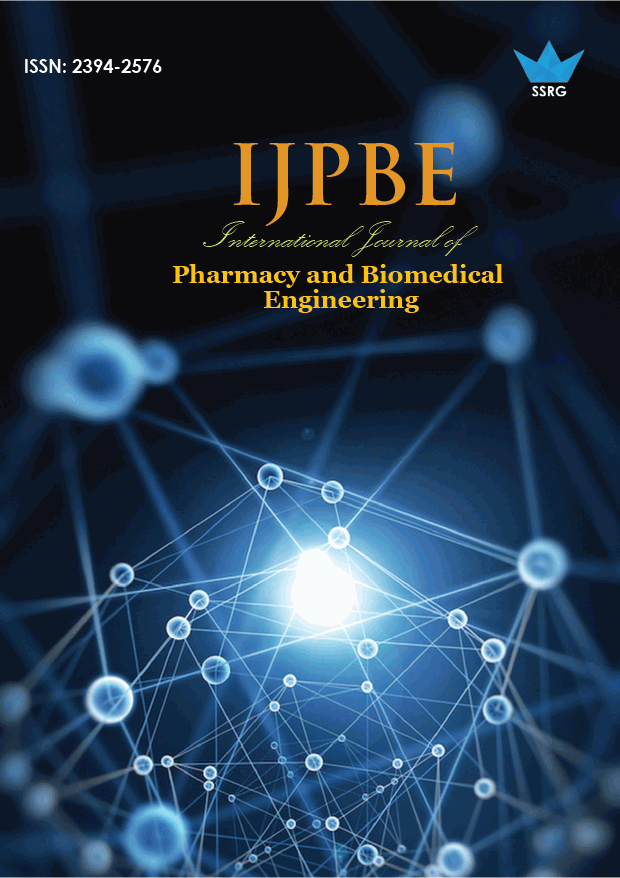Pharmacognostic study of Eranthemum nigrum Root DSNBK Prasanth

| International Journal of Pharmacy and Biomedical Engineering |
| © 2017 by SSRG - IJPBE Journal |
| Volume 4 Issue 3 |
| Year of Publication : 2017 |
| Authors : A. Lakshmana Rao |
How to Cite?
A. Lakshmana Rao, "Pharmacognostic study of Eranthemum nigrum Root DSNBK Prasanth," SSRG International Journal of Pharmacy and Biomedical Engineering, vol. 4, no. 3, pp. 1-7, 2017. Crossref, https://doi.org/10.14445/23942576/IJPBE-V4I3P101
Abstract:
To analyze the pharmacognostic characteristics and physicochemical parameters of the root of Eranthemum nigrum (E. nigrum). Microscopic characters and powder analysis had been carried out with the help of a microscope. The physicochemical properties such as loss on drying, total ash value, acid insoluble ash value, water-soluble ash value, extractive values, and fluorescence of E. nigrum had been performed. The color, shape, size, odor, and surface characteristics were reported from the root and powdered root material of E. nigrum. Light microscope images of cross-section and powdered root revealed lignified xylem fibers, xylem vessels, cork cells, and parenchyma cells. Phytochemical testing confirmed steroids, alkaloids, tannins, saponins, carbohydrates, glycosides, amino acids, and proteins. Physicochemical parameters such as moisture content, ash value, extractive value, and fluorescent behavior of root powder have also been established. The morphological, microscopical, and physicochemical parameter results provided in this paper may be utilized as a basis for the preparation of a monograph on E. nigrum root.
Keywords:
Pharmacognostic, Eranthemum nigrum, Diacytic stomata, Lignified xylem vessels, Phytochemical and Physicochemical analysis.
References:
[1] Akbar S, Hanif U, Ali J, Ishtiaq S. "Pharmacognostic studies of stem, roots, and leaves of Malva parviflora L". Asian Pac J Trop Biomed. 2014;4(5):410-5.
[2] Amponsah IK, Mensah AY, Otoo A, Mensah MLK, Jonathan J. "Pharmacognostic standardization of Hilleria latifolia (Lam.)" H. Walt. (Phytolaccaceae). Asian Pac J Trop Biomed. 2014;4(12):941-6.
[3] Randhawa GS, Mukhopadhyay A. Floriculture in India. New Delhi: Allied Publ.; 2004.
[4] Thekkayam, SG, Peter KV. Ornamental plants. New Delhi: New India Pub. Agency; 2009.
[5] Ona, NJ. Foliage: astonishing color and texture beyond flowers North Adams, MA: Storey Pub.; 2007. Available from: http://public.eblib.com/choice/publicfullrecord.aspx?p=4540 058.
[6] Samvatsar S, Diwanji V. Plants used for the treatment of different types of fevers by Bhils and its subtribes in India. 2004.
[7] Dhruv D, Anil T, Sanjay S, Sapna D. Antidiabetic and antioxidant properties of roots of Eranthemum roseum Vahl r. br. Inventi Rapid: Ethnopharmacology. 2010.
[8] Kamble S, Patil S, Sawant P, Sawant S, Pawar S, Singh E. Studies on plants used in traditional medicine by Bhilla tribe of Maharashtra. 2010.
[9] Jain A, Surana S, Gokhale S, Tatiya A, Bothara R. Antimicrobial Properties of Eranthemum roseum (Vahl) R. Br. Iran J Pharm Res. 2010;6(2):131-3.
[10] Milne-Redhead E. Eranthemum of the "Flora of Tropical Africa." Bulletin of Miscellaneous Information (Royal Botanic Gardens, Kew). 1936(4):255-74.
[11] Patil P, Surana S. Gastroprotective effect of Eranthemum roseum R. Br. Linn Root extracts in albino rats. Int J Pharmacol Biol Sci. 2009;3(1):81-93.
[12] Tatiya A, Desai D, Surana S, Patil P. Anti-inflammatory and nitric oxide scavenging activity of roots of Eranthemum roseum. 2007;44(11):815-8.
[13] Jhade D, Ahirwar D, Jain R, Sharma N, Gupta S. Pharmacognostic standardization, physico-and phytochemical evaluation of Amaranthus spinosus Linn. Root. J Young Pharm. 2011;3(3):221-5.
[14] Ghorpade P, Siddiqui A, Patil MJ, Rub RA. Pharmacognostic and phytochemical evaluation of Celosia argentea. Phcog J. 2012;4(33):7-15.
[15] World Health O. Quality control methods for herbal materials Geneva: World Health Organization; 2011.
[16] Khandelwal K.R. Practical pharmacognosy: techniques and experiments. Maharashtra: Niral Prakashan; 2008.
[17] Harborne A. Phytochemical methods a guide to modern techniques of plant analysis: springer science & business media; 1998.
[18] World Health O. Quality control methods for medicinal plant materials. Geneva: World Health Organization; 1998.
[19] Galani VJ, Patel BG. The psychotropic activity of Argyreia speciosa roots in experimental animals. Ayu. 2011;32(3):380-4.
[20] Dave R, Nagani K, Chanda S. Pharmacognostic Studies and Physicochemical Properties of the Polyalthia longifolia var. pendula Leaf. Phcog J. 2010;2(13):572-6.
[21] Vaghasiya Y, Nair R, Chanda S. Antibacterial and preliminary phytochemical and Physico-chemical analysis of Eucalyptus citriodora Hk leaf. Nat Prod Res. 2008;22(9):754-62.
[22] Prasanth D, Rao AS, Yejella RP. Assessment of Pharmacognostic, Phytochemical and Physicochemical Standards of Aralia racemosa (L.) root. Ind J Pharm Edu Res. 2016;50(3): S225-S30.

 10.14445/23942576/IJPBE-V4I3P101
10.14445/23942576/IJPBE-V4I3P101